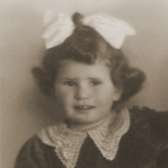
-
Learn More about Elzbieta
- Collections View Elzbieta's family papers and photographs
- First Person Listen as Elzbieta shares her Holocaust experiences at a First Person program
- Oral History Access to Elzbieta's Oral Testimony
Elzbieta grew up in Iwonicz, a resort town in southwestern Poland noted for its mineral water. Her father, Edmund, was a respected physician and her mother, Helena, had studied pharmacology. At home, they spoke Polish and were among the few Jewish families who lived in Iwonicz.
German troops invaded Poland on September 1, 1939. Seventeen days later, the Soviet army invaded from the east. Edmund, who served in the Polish army, was captured by the Soviets. They sent him to a camp in Novosibirsk (Siberia), where he served as a physician. In November 1939, Elzbieta and her mother went to Tarnów, where her maternal grandmother lived. There they were subjected to a growing number of Nazi anti-Jewish measures, such as forced labor. Helena worked as an assistant pharmacist for the Germans.
In June 1942, the Germans deported some 3,500 Jews, including Elzbieta’s grandmother, to the Belzec killing center. Realizing the danger, Helena purchased “Aryan” papers for Elzbieta and herself and escaped to Milanówek, a town near Warsaw. There they lived with a Polish family. Four-year-old Elzbieta was given the name Barbara Stachura and raised as a Catholic. After the destruction of the Warsaw ghetto, German authorities intensified their efforts to find Jews in hiding. Helena worried that they would be discovered and sometimes kept her daughter from school or hid her in the basement.
In January 1945, Soviet troops occupied Milanówek. In May, Elzbieta’s mother bribed a Russian soldier to smuggle them in shipping crates across the border to Czechoslovakia. From there, the two went to Austria and then Germany, where they learned that Edmund had survived and was in Italy with the Polish army. In 1951 Elzbieta and her family came to the United States. Elzbieta volunteered at the United States Holocaust Memorial Museum.





